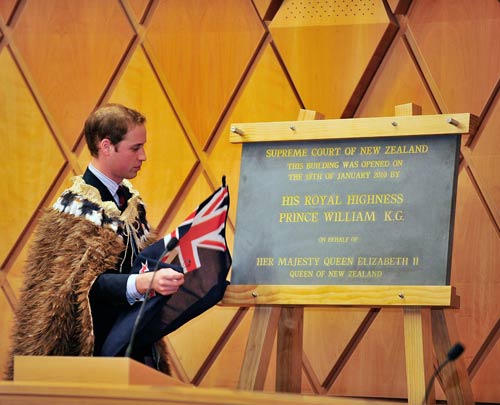The recent High Court decision (NZTA v Architectural Centre Inc & Ors) appears to have put an end to the flyover in the short term … but what are NZTA’s options now for the Basin Reserve?
1. Seek leave to the Supreme Court to appeal the High Court decision

Following the High Court decision (21 August 2015), NZTA have the right to seek leave to appeal to the Supreme Court. The Supreme Court can agree to hear the appeal itself, dismiss the application for leave, or allow NZTA to appeal to the Court of Appeal with no right to appeal to the Supreme Court.
NZTA have 10 working days after the decision (ie. until Friday 4 September) to seek leave to appeal.
The relevant clauses from the Resource Management Act are:
149V(5) No appeal may be made to the Court of Appeal from a determination of the High Court under this section.
149V(6) However, a party may apply to the Supreme Court for leave to bring an appeal to that court against a determination of the High Court and, for this purpose, section 12 to 15 of the Supreme Court Act 2003 apply with any necessary modifications.
149V(7) If the Supreme Court refuses to give leave for an appeal (on the grounds that exceptional circumstances have not been established under section 14 of the Supreme Court Act 2003), but considers that a further appeal from the determination of the High Court is justified, the court may remit the proposed appeal to the Court of Appeal.
149V(8) No appeal may be made from any appeal determined by the Court of Appeal in accordance with subsection (7).
Why might NZTA chose to do this?
If the NZTA considers that the Supreme Court might come to a different view to the High Court, they would appeal the High Court decision. This would have to be balanced with the likely negative public perception, given the Board of Inquiry and the High Court decisions went against them, and a desire to make progress on coming to a solution at the Basin Reserve, as a further appeal will cause further delays.
2. Put through special legislation

In 2012 the government introduced the National War Memorial Park (Pukeahu) Empowering Bill on 23 August. The bill was passed in its third reading on 27 September, with the royal assent being given on 3 October 2012. This granted the designation and all the necessary resource consents to construct the Arras Tunnel. It would be possible for the government to use this mechanism to also grant the designation and resource consents for the Basin Reserve flyover, but given it has been turned down by a Board of Inquiry, whose decision was upheld by the High Court, this would appear to many to be a misuse of the government’s power.

It would be an extreme and unusual step to use special legislation given these decisions. Robert Muldoon took this step to legislate for the Clyde Dam (Clutha Development (Clyde Dam) Empowering Act 1982) in order to overcome a successful High Court appeal and a subsequent Planning Tribunal decision against the government (Gilmore v National Water and Soil Conservation Authority and Minister of Energy (High Court, 1982), Annan v National Water and Soil Conservation Authority and Minister of Energy (Planning Tribunal, 1982)).
The government would also have to consider recent claims, for example by Duncan Garner, that it is suffering from the arrogance of third-termitis. The government would be vulnerable to similar attacks if there was a decision to grant a designation for the flyover using this mechanism.
Why might NZTA chose to do this?
Special legislation is a guaranteed way for the NZTA to achieve exactly what they want if the government agrees to this. The government would need ACT and the Māori Party to support any Bill. Given their recent media releases and statements in the house, it is unlikely that Labour, the Greens or United Future would agree to such a Bill. Last year, following the Board of Inquiry decision, New Zealand First’s Denis O’Rourke supported the Board’s decision, and called for a light rail alternative to be reconsidered, suggesting that NZ First would also not support any special legislation.
3. Lodge a Notice of Requirement for the flyover, the Mt Victoria tunnel duplication and the widening of Ruahine St
The NZTA has the right to lodge a Notice of Requirement for any of its projects at any time. Much of the discussion at the Basin Bridge Board of Inquiry queried why NZTA had not included the Mount Victoria tunnel duplication and widening of Ruahine St in the application to build the flyover at the Basin Reserve. The Decision noted at paragraph [234]:
“we must determine whether the project before us meets the Act’s sustainable management purpose as a stand-alone Project (i.e. in the absence of the Mt Victoria Tunnel duplication), and on the basis of the information regarding the outcomes of the Public Transport Spine Study available to us. That is the key consequence of the Transport Agency’s decision to seek approval for the Project as a stand-alone project separate from that of the Mt Victoria Tunnel duplication, and in advance of the Public Transport Spine Study and its outcomes being finalised.”
Lodging these projects together does not mean they all have to be constructed at one time. They could be staged according to whatever worked best for NZTA. It would mean however that NZTA would have to properly consult and consider alternatives (including tunnel-options and other non-flyover options) following the High Court decision.
The High Court decision has also confirmed that the Basin Bridge Board of Inquiry was right in law to take into account the heritage values of the wider area, including heritage, such as the Basin Reserve, which is not listed on the District Plan heritage list. These values would need to be considered in any new application.

Another relevant issue is the proposed Town Belt Bill, which is scheduled to be introduced to Parliament on 16 September 2015. Grant Robertson’s Bill aimed to increase the size of the town belt (by 100 hectares) and increase its protection, allowing only land taken via the Public Works Act and requiring land swaps in those circumstances. Recently though the WCC has agreed to government suggestions that compulsory acquisition be allowed prior to compensation being settled. The Wellington Chamber of Commerce has welcomed this change saying that otherwise certain clauses “could affect such vital projects as the Mt Victoria tunnel duplication and parts of the bus rapid transit route.”
Why might NZTA chose to do this?
When NZTA sought public feedback in its mid-2011 public engagement, the brochure providing information included material on both the proposed flyover, the Mt Victoria tunnel duplication and the widening of Ruahine St, demonstrating the inter-linked nature of these projects. Since this time, the Public Transport Spine Study (PTSS) project has recommended a Bus Rapid Transport (BRT) link to the eastern suburbs, which may impact on the Mt Victoria Tunnel duplication project and how much land is needed to be taken from the Town Belt (WCC p 7 g(i) and (l)). The redesign of these projects to include BRT may impact on how soon NZTA will be ready to file documents for a Notice of Requirement for these two projects. This of course assumes that, after adequate consideration of alternatives, these projects are still found to be NZTA’s preferred options.
4. Start from scratch …
It would appear from recent comments in the media and in Parliament that NZTA has suffered a significant dent to its credibility through this process to get approval to build the flyover. The Dominion Post, which was formerly one of the flyover’s strongest advocates, has recently (24 August 2015) said that “it is time to try something else,” and reported that:
“The agency is now widely viewed as a come-hell-or-high-water outfit which doesn’t change its mind lightly, if at all. There are plenty of Wellingtonians who think of it as arrogant and inflexible, a one-eyed behemoth which cares about roads and very little else.”
Peter Dunne in Parliament last week (26 August 2015) has similarly called for an end to the flyover (“this is the time to drop this crazy idea”) and described the NZTA as “an arrogant “we know best” organisation” and noted that the:
“… court decision provides now an opportunity for the Minister to restructure the organisation, to make it more responsive to community needs, and for the government’s transport priorities to now be able to be implemented in a way that more reflects the best interests of the communities that they seek to serve, not the best interests of those that play with desktop solutions within NZTA day in and day out. This has been a complete disaster. We need to learn from it and move on.”
NZTA would have to do significant work to convince many community groups that any decision to start from scratch was genuine, yet this is something a number of groups have been lobbying the local politicans in the GWRC and WCC for since the Basin Bridge Board of Inquiry Decision. Such a move would be largely welcomed by community groups, though it would also likely be accompanied by an expectation that light rail was put back on the table as a solution to traffic congestion. Light rail appears to also still be supported by some Regional Councillors.
Why might NZTA chose to do this?
It has appeared to many that NZTA has long had an internal culture battle between “the engineers” and “everyone else.” Political pressure may now mean that different ways of doing things are more palatable and the time required to start from scratch could be seen as an investment in the long awaited culture shift. Outgoing Chief Executive Geoff Dangerfield might see the time as right to signal a new direction for whoever succeeds him.
A summary of the recent High Court decision (NZTA v Architectural Centre Inc & Ors) can be found at: http://architecture.org.nz/basin/high-court-decision-summary/

Leave a Reply